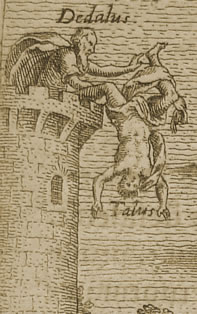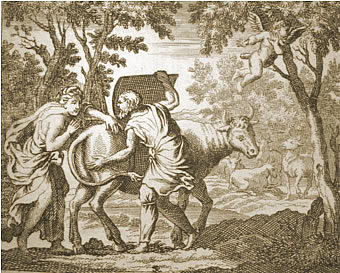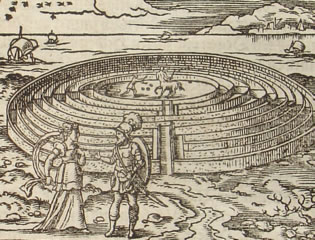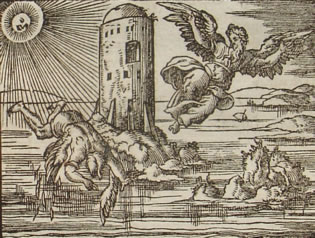The unexpected death of King Minos of Crete during a visit to Sicily has everyone talking, but not just about him. Sources report that Justice-siring Zeus appointed Minos, upon his death, one of the three judges of the Underworld as a reward for upholding justice in his kingdom (Harris 287). Initial concerns from the Cretans about the fate of their respected leader have waned with news of Minos’ establishment in this enviable position in Hades. Feeling comforted by Zeus’ appointment, the people are now talking about the famous craftsman, Daedalus, Minos’ friend-cum-enemy.
People throughout Greece have been captivated by Daedalus’ creations. But it’s not just his artwork that everyone is talking about. The Cretans are as much preoccupied with unraveling the scandalous mysteries that surround this artisan as they are with venerating his creations.
A frequent source of gossip concerns his parents. Though speculation exists about the true identities of Daedalus’ biological parents, it is no secret that he inherited his artistic gift from the gods, not from a couple of mere mortals. His mother’s identity is anyone’s guess, and many people have their own theories about who she is. Some say she is a woman by the name of Alcippe; others, Merope; and still others think she is Iphinoë (Graves 85).
People do not lose sleep over this uncertainty, however, because what’s a mother anyway? Knowing the father is much more important, and people throughout Greece agree on one thing: Daedalus’ father is either Eupalamos, "good with hands," or Metion, "knowledgeable," which, either way, makes him the grandson of Erechtheus (Tatham 65). Erechtheus is the son of Erichthonius, the offspring of Hephaestus’ attempted rape of Athene (Harris 9). This places the artistically-well-endowed Daedalus, whose name is derived from the word daidalon, meaning "every skillfully performed piece of workmanship" (Tatham 73), in a direct line of descent from Hephaestus and Athene, patron deities of the arts and creativity. Some people even claim that in addition to inheriting his gift from these gods, he was personally instructed in the arts by Athena herself (Graves 85).

Daedalus’ nomadic lifestyle, which gives him the appearance of not having a native city, is another conversational centerpiece throughout Greece. After some preliminary digging, however, a team of well-connected reporters for the Argos discovered that Daedalus is nomadic by force, not by choice. It is no surprise that, as a descendant of Athena, he was originally a native of Athens. He fled the city, however, to escape the penalty of being convicted of murder (Schwab 83).
According to this team of reporters, Daedalus murdered his twelve-year-old nephew, Talus. Daedalus reportedly suffered great apprehension about the future of his own fame because, though still a boy, Talus showed insuppressible signs of innovative genius. His invention of the saw, which he fashioned after the zigzagging appearance of a snake’s teeth, made him famous throughout Athens before he reached puberty. Reports have it that as Talus’ patron, jealous-minded Daedalus feared his nephew would soon surpass—or suspected he already had—his own creative abilities (Graves 85). One day, in a fit of envy over his nephew’s genius, Daedalus prevented being shown up by his pupil by hurling Talus from the top of the Acropolis. Young-but promising Talus died instantly. Unable to cover up his actions, Daedalus was convicted by the Athenian court of the Areopagus (Schwab 82-3).
This team of reporters could not find any Athenian documents stating Daedalus was ever punished for his crime. All sources agree that he escaped Athenian jurisdiction by fleeing to the island of Crete. Cretan locals report that once he was there, he wasted no time befriending King Minos, who was already familiar with and impressed by his artwork. This friendship, however, would prove costly and burdensome to the king. Local Cretans claim Minos had deliberately deceived trident-wielding Poseidon, leading him to exact a most embarrassing revenge, a revenge that was later completed, albeit unknowingly, by Daedalus (Rose 95).
Bestial Passions Lead to Embarrassing Birth
Apollodarus, a local epistolarian, captured the scandalous details of Minos’ punishment. To prove his divine appointment to be the king of Crete, Minos claimed the gods would give him whatever he demanded, Apollodarus relates. Asking Poseidon for a bull so he could make a glorious sacrifice to the gods, Minos received a bull so magnificent he could not sacrifice it, so he hid it among his herd and sacrificed a lesser bull (139). What a mistake this was!
No mortal can dupe a god, especially with a sacrifice, the most important of all practices. "Because he had not sacrificed the bull Poseidon in anger made it wild and aroused desire for it in Pasiphae," Minos’ wife, Apollodarus recounts (139). A longtime Daedalus source reports that, unable to control her feverish, god-inflicted lusting for the bull of the gods, Pasiphae commissioned Daedalus to help her end her salacious afflictions. Never innovatively lacking, quick-thinking Daedalus built a "marvelously lifelike" wooden cow (Rose 95). Hiding inside this wooden frame, inappropriately-lusting Pasiphae consummate her desire with Poseidon’s bull.

Apollodarus remarked that Daedalus’ cow was so lifelike, "the bull came and mounted it as though it were a real cow" (139).
A longtime source of the Argos, Ovid, reports that after she had coupled with this bull, Pasiphae had no means of denying her god-inflicted union with Poseidon’s gift. He attests, "Proof that [Minos’] wife was mounted by a bull / Was clear enough to all who saw her son / Half beast, half man, a sulky, heavy creature" (219). Pasiphae’s child ironically acquired the name Minotaur, or "Minos’ bull" (Rose 96), a name which continually reminds Minos that he is to blame for this creation because his deception of Poseidon led to Pasiphae’s bestial fecundity.
Accepting Pasiphae’s commission and helping her appease her lusty desire, Daedalus’ craftsmanship ultimately landed him a new job—and this time for the king himself. Sources report that needing a means of keeping the Minotaur—the ever-present symbol of Minos’ lie and Pasiphae’s infidelity—underwraps, mistake-hiding Minos hired Daedalus to build an intricate labyrinth to house this undesirable offspring (Schwab 83). This labyrinth has become the most famous and renowned of all his creations.
Ovid heralded this structure as "a labyrinth that tricked the eye" (219). An account from a passerby who witnessed the completion of this spectacle offers a more romantic description of the Minotaur’s lodging:
[A] structure full of intricate windings which bewildered the eyes and the feet of anyone who entered it. The countless corridors twined like the serpentine flow of the Phrygian river Maender, which seems to turn back upon its course and meet its own waves. When the building was completed and Daedalus went over it, he, its builder, could scarcely find his way back to the threshold. (Schwab 83)
With the completion of this impossible maze, Daedalus added yet another item to his already-outstanding resumé, and Minos got the satisfaction of knowing that the embarrassing offspring of his unfaithful wife would be hidden from the world forever.
Craftsman Confined to Tower Cell
Local Cretans frequently entertain themselves with gossip about Daedalus’ imprisonment in a tower far above the labyrinth, although their accounts differ significantly. Some believe Minos punished Daedalus for making a mockery of him and his wife by helping her couple with the bull (Graves 88). Most people, however, advocate a more scandalous story of love, betrayal, and human sacrifice.
Proponents of this second version claim that every nine years, King Minos "fed the creature on Athenian blood," reports Ovid (220), giving him a sacrifice of fourteen Athenian youths. Minos demanded this payment as recompense for the murder of Poseidon’s bull by Theseus, an up-start Athenian youth famous for completing other such feats of strength (Graves 94). Inside the labyrinth, these seven boys and seven girls were forced to wander aimlessly, without hope of escape, until they were eventually found and eaten by the Minotaur. As Ovid tells it, "when a third nine years had made their round the monster faced the season of his doom" (220).
According to these advocates, Theseus was one of the fourteen youths sent to Athens for the third round of sacrifices. Having incurred this vicious cycle of sacrifices by murdering the Minotaur’s father, Theseus was undoubtedly strong enough to kill the Minotaur, too. Strength alone, however, would only prevent him dying at the hands of the Minotaur, but would not profit him in escaping the labyrinth. But Theseus was in luck.
When Theseus arrived at Crete, Ariadne, Minos’s daughter, fell madly in love with him, recounts Carlos Parada, a longtime friend of Daedalus who happened to witness the love-inspiring meeting of this soon-to-be-scandalous couple. She promised to help him escape, but only if he promised to marry her and take her with him back to Athens. Theseus undoubtedly agreed ("Theseus")

To make due on her promise, Ariadne sought out problem-simplifying Daedalus, who offered her a simple solution to the complex labyrinth, which she then related to Theseus. Following Ariadne’s instructions, Theseus carried a ball of thread with him through the labyrinth, and, upon killing the Minotaur, followed the thread back to the entrance (Graves 95). Theseus then ran away with Ariadne, witnessed Parada, but deserted her on the island of Naxos where she died ("Theseus").
Daedalus, who, as one of the locals described, "obeyed orders and fulfilled demands unquestioningly, without any moral quibbles getting in the way" (Tatham 104), apparently had no qualms with the fact that he had been commissioned by three different people on three separate occasions to complete tasks that ultimately caused the conception, imprisonment, and death of the Minotaur.
An interview with Parada revealed that Minos was infuriated by Daedalus’ treasonous support of Theseus. To punish him, Minos locked him and his son, Icarus, in a tower above the labyrinth ("Daedalus").
hough the locals enjoy advocating their different opinions about whether Daedalus was imprisoned for helping Pasiphae couple with the bull or for helping Theseus escape the labyrinth, they have the most fun retelling the story of Daedalus’ escape from the tower. So popular is this story, it is told throughout Greece with only slight variation.
The Death of Ambitious Icarus: Negligence or Vengeance?
Confined in an elevated prison, Daedalus was barred from escaping via the water that he overlooked on one side or the land on the other. Ovid attests that, with no other options available, "Daedalus turned his mind to subtle craft, / An unknown art that seemed to outwit nature" (220). In a moment of wholly new innovation, Daedalus used his divinely-inherited craftsmanship to contrive a means of using the air to aid his escape.
Ovid, always able to get the inside scoop, reports that Daedalus, aided by his son, gathered falling feathers from the birds that flew past his window so he could make wings for his escape. He arranged these feathers in a row, with each being slightly longer than the one before it. Ovid’s vivid description of the arrangement of the feathers captures the precision and care with which Daedalus constructed these wings:
the feathers traced an inclined plane
That cast a shadow like the ancient pipes
That shepherds played, each reed another step
Unequal to the next. (220)
Daedalus fastened the quills together with wax, bound the middles of the feathers with thread, and then curved the edges slightly "till they looked like eagles’ wings," Ovid described (221).
After completing two sets of wings, Daedalus turned his attention to squelching Icarus’ youthful ambitions. He reminded Icarus of the importance of Apollo’s maxim of nothing in excess, warning him that he must fly the golden mean, the midpoint between two extremes (Harris 1017). Daedalus commanded Icarus not to fly too near the water, lest his wings become waterlogged from the moisture, and not to fly too close to the sun, lest the wax that held his wings together melt. With this final and most important warning, they departed (Schwab 84).

Having pieced together various sightings by farmers and fishermen who witnessed this spectacle of flight, Ovid indicates that Daedalus and Icarus must have been together as they passed the islands of Delos, Paros, Samos, and even Lebinthus (220). But his account ends here. There were no further sightings of this father-son duo together. Overcome with ambition, Icarus desired to touch the sun and see the heavens. Dangerously disregarding Apollo’s maxim, he flew too high and the sun’s heat melted his wings. Uselessly flailing his arms in a repenting attempt to regain flight, Icarus plummeted to his death in the sea, just off the coast of Asia Minor. Icarus’ death has everyone asking whether he was fated to ignore the golden mean or if the gods intervened to avenge Talus, the boy Daedalus jealously murdered to ensure his own fame (Schwab 85).
Mourning his son, but having no time to spare for fear Minos would find and recapture him, Daedalus buried Icarus on an island that now bears the name Icaria in tribute. All accounts claim he then fled to Sicily (Graves 88). As happened at Crete, Daedalus immediately found refuge with King Cocalus of Sicily, recounts Parada ("Daedalus").
Sicilians First to get Indoor Heating
Daedalus wasted no time bestowing his majestic craftsmanship upon the people of Sicily. Sicilian locals claim that Daedalus’ first gave the landscape a much-needed facelift, by creating a marvelous, artificial lake that overflowed into the nearby ocean. Reciprocating the protection he was receiving from Cocalus, he next built the king a naturally well-fortified resort upon a rocky plateau, which would offer the king a safe place for himself and his treasures in the event of an emergency. His most appreciated creation, however, was his invention of indoor heating; he accomplished this by capturing the steam from subterranean fires, which could then be used to warm a room (Schwab 85). Life for Daedalus in Sicily was good, and safe from Minos. But not for long.
Daedalus was not the only crafty individual in Greece. Desiring to punish Daedalus, King Minos devised a cunning method of locating him. Reports from various kings throughout Greece indicate that royally-upset Minos sought out this turn-coat by proposing a challenge only he could solve.
The challenge: to thread a Triton shell!
Sources report that when Minos arrived in Sicily, King Cocalus heartily accepted the challenge, which, without informing Minos, he passed on to Daedalus. Locals who watched Daedalus complete this feat of creative genius describe that he drilled a hole in the tip of the shell and then coaxed an ant up the spirals by covering the hole with honey. Having tied a thread to the ant’s leg, when it crawled through the hole the shell was threaded and the challenge was completed. Knowing Daedalus was the only craftsman smart enough to solve the riddle, Minos knew it was him, not Cocalus, who had completed the task (Graves 89).
Boiling with rage, as the locals described, Minos wanted Daedalus dead and was prepared to stop at nothing until he was. But no one could outwit this divinely-skilled artisan, who conspired with Cocalus against Minos.
Cocalus invited Minos to take a bath to recover from his long journey. While Minos was bathing, Daedalus poured scolding water on him via a pipe system he had constructed for this purpose. Minos died instantly. Minos’ body was then returned to Crete, where it was buried by his former subjects under the impression he had been the victim of a tragic accident (Graves 89).
Famous throughout Greece for his god-inherited craftsmanship, Daedalus is equally famous for the trail of single-handed havoc he left behind. He caused Pasiphae to cuckold Minos. He aided in the birth, imprisonment, and death of the Minotaur. He helped Theseus kill the Minotaur, which disgraced Minos and led to the death of his daughter, Ariadne. He incurred his own imprisonment, which, in trying to escape, caused the death of his son. And, to top the list, he eventually killed King Minos. With this track record, it is no wonder Daedalus is the hot ticket item of conversation throughout Greece!
A word to the wise: Though his creations are magnificent, employing him is a plague. All who commission Daedalus will see their undoing. Obey Apollo’s credence and do not lust for dainty creations and you will avoid the tragic downfall that Minos suffered.
Works Cited
Apollodorus. Gods and Heroes of the Greeks: The Library of Apollodarus. Trans. Michael Simpson. Amherst: U of Massachusetts P, 1976. NetLibrary. 2007. 27 Jan. 2007.
Graves, Robert. Greek Myths. New York: Doubleday, 1981.
Harris, Stephen L., Gloria Platzner. Classical Mythology: Images and Insights. 4th ed. Boston: McGraw, 2001.
Ovid. The Metamorphoses. Trans. Horace Gregory. New York: Viking Press, 1958.
Parada, Carlos. "Ariadne." Greek Mythology Link. 1997. 27 Jan. 2007. <http://www.maicar.com/GML/Ariadne.html>.
---. "Daedalus." Greek Mythology Link. 1997. 27 Jan. 2007. <http://www.maicar.com/GML/Daedalus.html>.
---. "Theseus." Greek Mythology Link. 1997. 27 Jan. 2007. <http://www.maicar.com/GML/Theseus.html>.
Rose, H.J. Gods and Heroes of the Greeks: An Introduction to Greek Mythology. New York: World Publishing, 1958.
Schwab, Gustav. Gods and Heroes: Myths and Epics of Ancient Greece. New York: Pantheon Books, 1974.
Tatham, Peter. The Making of Maleness: Men, Women, and the Flight of Daedalus. New York: New York UP, 1992.